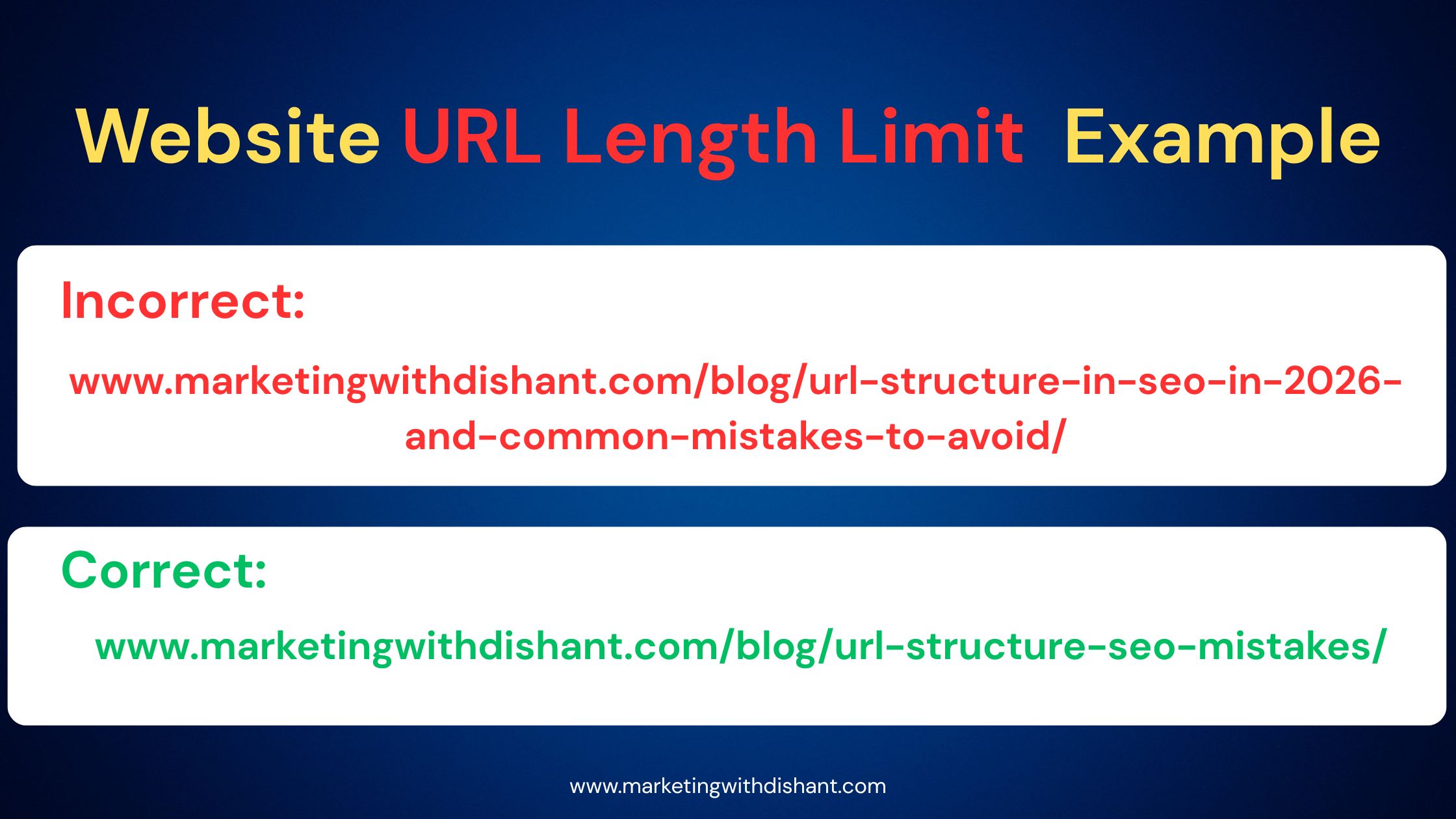When we talk about Search Engine Optimization (SEO), most people focus on keywords, backlinks, or content optimization, but one more factor we ignore is your URL structure.
The URL Length Limit plays an important role. It defines how search engines and users view your web page. A well-structured, short URL looks clean, improves click-through rates (CTR), and even helps your pages rank better in Google Search Engine Results Page.
What does Google love?
A clean and simple URL structure or a complex URL structure. Here are the best examples to easily understand the concept:
SEO User-friendly URL Structure:
https://www.example.com/blog/seo-url-tips
Complex URL Structure:
https://www.example.com/index.php?id=1234&cat=seo&session=xyz
The first one is simple, easy to remember, and gives a clear idea of what the page is about.
According to Google’s official guidelines, Google recommends keeping URLs short, descriptive, and easy to understand for both users and search engines.
What is the Meaning of URL Length Limit?
The URL Length Limit refers to the maximum number of characters a browser or search engine can handle in a web address.
Every web page you visit has a unique or different URL (Uniform Resource Locator), which tells your browser how to access it. However, if the URL becomes too long or complicated, it can create issues both technically and in terms of SEO as well.
A long URL usually contains unnecessary query parameters, tracking codes, or random strings of letters and numbers. For example:
- Too Long and complex URL:
https://www.example.com/products/list?cat=electronics&session=ab12cd34ef56gh78&source=ad&utm_campaign=sale&utm_source=google - Short and Clean URL:
https://www.example.com/products/electronics
Now, both URLs lead to the same page, but the second one is easier to read, share, and remember.
Why URL Length Matters?
User Experience:
Shorter URLs are easier to share on social media or in messages. They also look cleaner in search results. It creates big impacts on user experience.
Search Engine Crawling:
Googlebot and other crawlers can easily crawl and understand shorter, keyword-rich URLs. Extremely long URLs might be truncated or misinterpreted.
Click-Through Rate (CTR):
Users are more likely to click on a simple, meaningful URL because it clearly shows what the page is about.
Link Sharing:
Long URLs may break when shared via email or messaging apps. This can create a bad impression for our website.
Pro Tip: In simple words, your URL should describe the page in a short sentence.
How Maximum Long URL Length Limit in Google SERP?
When it comes to Google’s SERP (Search Engine Results Page), there is no officially defined maximum URL length limit, but there are practical limits across browsers and search engines.
Approximately Browser URL Length Limits:
- Google Chrome: Around 2,048 characters
- Firefox: Can handle up to 65,536 characters
- Microsoft Edge / Internet Explorer: Around 2,083 characters
While these numbers seem large, you should never actually create URLs that long. In the real world, SEO, URLs longer than 115 characters start to look messy and are harder to manage for crawlers.
What Google Shows in SERPs
Google usually displays only around 65-70 characters of a URL in its search results. That means even if your URL is long, users will only see a small portion of it.
Google can index long URLs, but it is better to keep them short for both visibility and user experience.
SEO Recommendation
For best SEO practices, keep your URL:
- Under 60 – 70 characters
- Short, descriptive, and keyword-focused
- Don’t use unnecessary numbers or symbols
Top 5 Tips to Make SEO-Friendly URLs

Creating an SEO-friendly URL doesn’t require coding. It needs just a few smart practices. Here are the top 5 proven tips from my personal experience to make your URLs clean, professional, and optimized for search engines.
1. Keep URLs Short and Simple
A short URL is easier to read, type, and share. Always try to remove extra words and parameters. Mainly, your URL should stay under 100 characters and describe your page clearly.
You can check the following Example:
Incorrect: /how-to-create-the-best-url-length-limit-for-seo-in-2025-step-by-step-guide
Correct: /url-length-limit-seo-guide
2. Include Your Main Keyword
It must include your focus keyword in the URL tells search engines what your page is about. Need to avoid stuffing multiple keywords, though one main keyword is enough.
3. Avoid Unnecessary Parameters
URLs filled with symbols or special characters like ?, &, =, and numbers look confusing. They also make your URL harder to index. Always create cleaner and user-friendly URLs while doing SEO.
4. Use Hyphens (-) Instead of Underscores (_)
Hyphens are the recommended way to separate words in a URL. Google treats hyphens as space separators, but does not do that with underscores.
So, always prefer:
Correct: example.com/url-length-limit
Incorrect: example.com/url_length_limit
This small detail can make your URL more readable for both users and bots.
5. Keep URLs in Lowercase
URLs are case-sensitive. That means /URL-Length-Limit and /url-length-limit are treated as two different pages, which can cause duplicate content issues.
To avoid this, always use lowercase letters in your URLs. It looks consistent, professional, and prevents SEO confusion.
Mistakes to Avoid While Creating a URL for SEO
Even experienced webmasters make small URL mistakes that can impact rankings. Here are the most common ones you should avoid:
Using Stop Words: Avoid common words like “and”, “the”, “of”, or “in” in your URL unless they are necessary for clarity.
For Example:
Incorrect: /the-best-url-length-limit-for-seo
Correct: /best-url-length-limit-seo
Keyword Stuffing: If we repeat the same keyword in the URL makes it look spammy.
Incorrect: /seo-tips-for-seo-beginners
Correct: /seo-tips-beginners
Adding Special Characters: If we are adding special characters such as @, %, #, or & can break URLs or cause encoding errors. Always use only letters, numbers, and hyphens.
Incorrect: /seo#tips%guide
Correct: /seo-tips-guide
Ignoring Redirects After Changing URLs: If you update or shorten a URL, always use a 301 redirect to point the old URL to the new one. This ensures that your old backlinks and traffic don’t get lost.
Old: /long-url-length-limit-guide
New: /url-length-limit
Redirect: 301 → from old to new.
Including Unnecessary Dates or Years: Adding years like “2022” or “2023” in your URL can make your page look outdated later. Instead, use evergreen URLs that remain relevant over time.
Incorrect: /2023/url-length-limit-seo
Correct: /url-length-limit-seo
Mixing Multiple Topics in One URL: Every URL should represent one topic or intent. Don’t mix multiple subjects in one link.
For example, avoid something like:
/seo-tips-url-structure-backlink-guide
It is a confusing URL structure. Instead, create separate URLs for each topic.
Forgetting About Mobile Sharing: Remember, many users access your site through mobile. Long URLs can break in text messages or social media posts. A short, clean URL is always mobile-friendly and easy to copy or share.
Conclusion
The URL Length Limit might seem like a technical detail, but it plays an important role in your overall SEO performance. A clean and optimized URL helps search engines understand your page, boosts organic visibility, and makes your content easier to share.
A well-structured URL not only improves SEO but also builds user trust and trust leads to better engagement and conversions. So, the next time you create or optimize a webpage, don’t ignore your URL Length Limit. It is a small step that makes a big impact on your website’s long-term SEO success.
FAQs on URL Length Limit
What is the maximum URL length limit in browsers?
Most browsers can handle URLs up to around 2,000 characters, but it’s generally recommended to keep URLs under 2,048 characters for compatibility and readability.
What is the URL length limit in Google Chrome?
Google Chrome supports URLs up to approximately 2,048 characters. However, URLs longer than that might get truncated or may not work properly in certain cases.
What is the URL length limit in Firefox?
Mozilla Firefox can handle URLs up to around 65,536 characters (64 KB), which is much higher than Chrome’s limit.
Is there a URL length limit in Internet Explorer or Microsoft Edge?
Yes. Internet Explorer has a maximum URL length of 2,083 characters, while Microsoft Edge follows Chrome’s limit of about 2,048 characters.
Do special characters affect the URL length limit?
Yes. Special characters like (%, &, ?, =,) and others are encoded in URLs, which increases the character count. For example, a space (“ ”) becomes “%20,” adding extra characters to the URL.
What is the recommended URL length for SEO?
For SEO purposes, try to keep URLs under 100–115 characters. Short, descriptive URLs are easier to read, share, and crawl by search engines.
What happens if a URL exceeds the length limit?
If a URL exceeds the browser’s limit, it might not load, return a URI Too Long error, or get truncated, leading to broken links, etc.
Do search engines have a URL length limit for indexing?
Search engines like Google can technically index long URLs, but they prefer shorter, cleaner URLs. Very long URLs may get truncated in the Search Engine Results Page.

